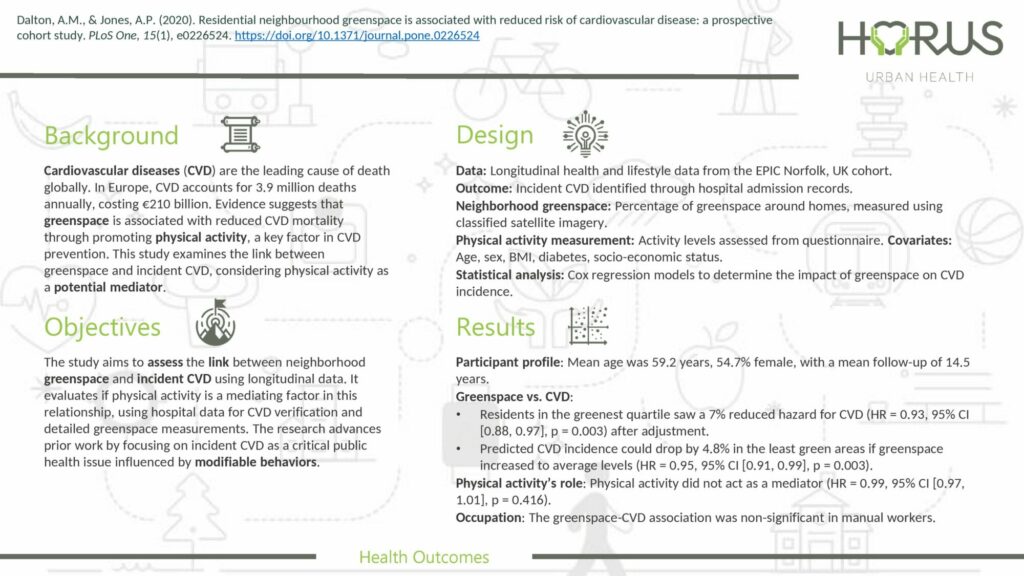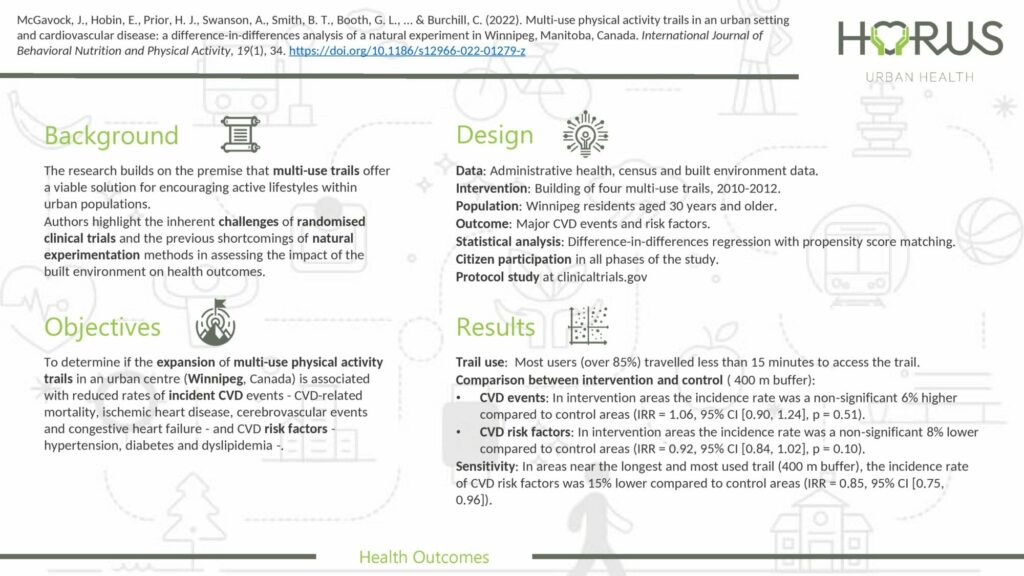HORUS keeps moving forward and is producing first results. UVEG is conducting a comprehensive literature review of urban interventions which have positive impact on NCD reduction, stratified by intervention and type of NCD, with the support of all partners.
Evidence-based interventions incorporated in the review include green spaces and the promotion of cycling and walking infrastructure. Territorial subsets of urban areas were also defined for the study, since the partnership needs to ensure sufficient variability in the natural conditions for experimentation.
Also, as for the pilots, in their respective urban areas, UVEG and MEDRI are collecting data on census tracts, including demographic, physical and socio-economic information. UVEG is stimating the annual incidence of NCDs in these areas from medical records, geolocating individual households and aggregating them to census tract level.This review will also identify the specific urban interventions implemented and the dates for each census tract from the data collected. Control/intervention group assignment for census tracts are being based on isochronal service areas, taking into account distance decay effects from the literature reviewed for each type of intervention. Concurrent environmental interventions that may act as confounding variables are also being identified. Temporal variables are defined to capture the effects of the staggered interventions at different time points, minimising the risks of bias. The result will be a panel data set with census tracts as units of observation that will be showcased in the future.
At this stage we would like to hightlight a couple of articles that were particularly interesting.

Dalton, A.M., & Jones, A.P. (2020). Residential neighbourhood greenspace is associated with reduced risk of cardiovascular disease: a prospective cohort study. PLoS One, 15(1), e0226524. https://doi.org/10.1371/journal.pone.0226524
Background
Cardiovascular diseases (CVD) are the leading cause of death globally. In Europe, CVD accounts for 3.9 million deaths annually, costing €210 billion. Evidence suggests that greenspace is associated with reduced CVD mortality through promoting physical activity, a key factor in CVD prevention. This study examines the link between greenspace and incident CVD, considering physical activity as a potential mediator.
Design
Data: Longitudinal health and lifestyle data from the EPIC Norfolk, UK cohort.
Outcome: Incident CVD identified through hospital admission records.
Neighborhood greenspace: Percentage of greenspace around homes, measured using classified satellite imagery.
Physical activity measurement: Activity levels assessed from questionnaire. Covariates: Age, sex, BMI, diabetes, socio-economic status.
Statistical analysis: Cox regression models to determine the impact of greenspace on CVD incidence.
Objectives
The study aims to assess the link between neighborhood greenspace and incident CVD using longitudinal data. It evaluates if physical activity is a mediating factor in this relationship, using hospital data for CVD verification and detailed greenspace measurements. The research advances prior work by focusing on incident CVD as a critical public health issue influenced by modifiable behaviors.
Results
Participant profile: Mean age was 59.2 years, 54.7% female, with a mean follow-up of 14.5 years.
Greenspace vs. CVD:
- Residents in the greenest quartile saw a 7% reduced hazard for CVD (HR = 0.93, 95% CI [0.88, 0.97], p = 0.003) after adjustment.
- Predicted CVD incidence could drop by 4.8% in the least green areas if greenspace increased to average levels (HR = 0.95, 95% CI [0.91, 0.99], p = 0.003).
Physical activity’s role: Physical activity did not act as a mediator (HR = 0.99, 95% CI [0.97, 1.01], p = 0.416).
Occupation: The greenspace-CVD association was non-significant in manual workers.

McGavock, J., Hobin, E., Prior, H. J., Swanson, A., Smith, B. T., Booth, G. L., … & Burchill, C. (2022). Multi-use physical activity trails in an urban setting and cardiovascular disease: a difference-in-differences analysis of a natural experiment in Winnipeg, Manitoba, Canada. International Journal of Behavioral Nutrition and Physical Activity, 19(1), 34. https://doi.org/10.1186/s12966-022-01279-z
Background
The research builds on the premise that multi-use trails offer a viable solution for encouraging active lifestyles within urban populations.
Authors highlight the inherent challenges of randomised clinical trials and the previous shortcomings of natural experimentation methods in assessing the impact of the built environment on health outcomes.
Design
Data: Administrative health, census and built environment data.
Intervention: Building of four multi-use trails, 2010-2012.
Population: Winnipeg residents aged 30 years and older.
Outcome: Major CVD events and risk factors.
Statistical analysis: Difference-in-differences regression with propensity score matching.
Citizen participation in all phases of the study.
Protocol study at clinicaltrials.gov
Objectives
To determine if the expansion of multi-use physical activity trails in an urban centre (Winnipeg, Canada) is associated with reduced rates of incident CVD events – CVD-related mortality, ischemic heart disease, cerebrovascular events and congestive heart failure – and CVD risk factors – hypertension, diabetes and dyslipidemia -.
Results
Trail use: Most users (over 85%) travelled less than 15 minutes to access the trail.
Comparison between intervention and control ( 400 m buffer):
- CVD events: In intervention areas the incidence rate was a non-significant 6% higher compared to control areas (IRR = 1.06, 95% CI [0.90, 1.24], p = 0.51).
- CVD risk factors: In intervention areas the incidence rate was a non-significant 8% lower compared to control areas (IRR = 0.92, 95% CI [0.84, 1.02], p = 0.10).
Sensitivity: In areas near the longest and most used trail (400 m buffer), the incidence rate of CVD risk factors was 15% lower compared to control areas (IRR = 0.85, 95% CI [0.75, 0.96]).

